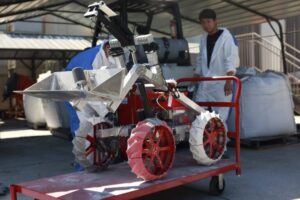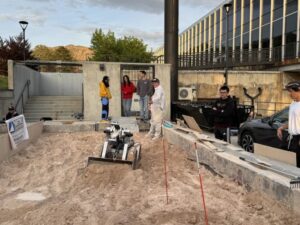
Each year, NASA hosts the Lunabotics Challenge, tasking college teams with building a prototype lunar rover and piloting it on a simulated mission. The goal is to engage students in the next phase of human space exploration, supporting the Artemis Campaign — NASA’s project to establish a long-term presence on the Moon.
At the end of May, the University of Utah’s Lunabotics team took home the Artemis Grand Prize, which goes to the Challenge’s overall top performer across a range of categories.
“During the 16th annual Lunabotics University Challenge the teams continued to raise the bar on excavating, transporting, and depositing lunar regolith simulant with clever remotely controlled robots,” said Robert Mueller, senior technologist at NASA Kennedy for Advanced Products Development in the agency’s Exploration Research and Technology Programs Directorate, and lead judge and co-founder of the original Lunabotics robotic mining challenge. “New designs were revealed, and each team had a unique design and operations approach.”
The Challenge’s 80 teams were tasked with designing a rover capable of building a berm structure—essentially, a protective embankment—from regolith, the layer of rocky debris that blankets the lunar surface. Such berms could be a key feature of an extended human presence on the moon, defending against ejecta during lunar landings and launches, shading cryogenic propellant tank farms, shielding a nuclear power plant from space radiation, among other uses.
In the finals, the U Team worked alongside their low-profile, front-loader-shaped robot within the competition arena’s simulated lunar environment. While in the arena, team members wore full-body protective gear consisting of bunny suits and N-95 masks, including helmets with respirators. This wasn’t just to complete the lunar look — BP-1, NASA’s regolith simulant, is made of fine silica particles which pose a lung-damaging biohazard. Protecting the robot from regolith’s corrosive qualities was also part of the challenge; before suiting up, the team had to demonstrate their acumen in a variety of technical and organizational categories.
“There’s nothing like the Lunabotics Challenge for getting hands-on engineering experience,” says Brycen Cheney, President of the Utah Student Robotics club and junior in the Department of Mechanical Engineering. “It gave me the chance to lead and be fully responsible for a multidisciplinary team, translate mission goals into working mechanical systems, and oversee a project from concept to execution. That’s part of why our team grew from thirteen to thirty this year — students see how this kind of hands-on, systems-driven work prepares them not just for NASA robotics, but for solving complex problems in any engineering field.”

On its way to the Grand Prize, the team took first place in the Presentation and Demonstration and STEM Engagement categories, second place in the Robotic Construction category, and a judge’s award for Best Use of Systems Engineering Tools. The team also won the “Efficient Use of Communications Power” Award, received an honorable mention in the “Autonomy” Award, and the award for “Sportsmanship” — a recognition the team earned by sharing hardware, offering technical support, and even giving up their own time slot to help others compete. Including the $5,000 that comes with the Artemis Grand Prize, the team took home $9,000 from these wins
Their cumulative scores in these categories put Team Utah in a position to win the Grand Prize, but it was their robot’s regolith-moving might that pushed them over the edge. Scoring in the Finals is partially based on the total volume of the constructed berms over two rounds; Utah’s total was more than twice the size of their next biggest competitor. The berm built in the second round of the Finals was the largest ever in the competition’s history.
“We were also the only team that was able to fully lift a rock that was an obstacle on the field,” says Jeff Hansen, team member and senior in Chem E and Computer Engineering. “Other teams were only able to push it around.”
The team credits their extensive preparation for their success.
“We took a new evolutionary design approach this year, where we focused on making a simple and functional robot quickly, and then improving it over time,” says Nathan Bruns, vice-president of the team and junior in Mechanical Engineering. “Usually, we haven’t had a competition-ready robot ready to test even up to the last week before the competition. But this year our new lunar simulant test pit outside of Merrill Engineering Building was a major factor in testing and improving our design — the regolith is more like super-dense powdered sugar than sand, so the test pit was very helpful to figure out how the robot behaved while driving and digging.”
The test bed, looking like an oversized sandbox, is filled with a silica ore known as Azomite, similar to the simulated lunar regolith of the competition but less of a health hazard. The team will use it to practice in future competitions, and share the space with other researchers and student groups.

Jon Davies, instructor in the Department of Electrical & Computer Engineering and one of the team’s advisors, was proud of his students’ technical accomplishments, but emphasized the bigger-picture skills that the competition develops.
“Utah Student Robotics have done very well at the NASA Lunabotics Competition,” Davies says. “Even with setbacks and some failures on the robot, the students had an amazing attitude and approach. They used their classroom knowledge to engineer solutions and really impressed the NASA judges and engineers.”
Some of these skills included the ability to organize sponsors to cover construction and travel costs. Major sponsors included the Utah NASA Space Grant Consortium, Metal Supermarkets Salt Lake City, Geneva Pipe and Precast, Make Salt Lake, Rock Utah, Runners Trucking Company, Macbeath Lumber, and The AZOMITE Company.
As the first team to dethrone powerhouses University of Alabama and the University of Iowa since the challenge’s inception in 2010, Utah is looking forward to defending the crown next year at Kennedy Space Center.
Utah Student Robotics is open to all students at the University of Utah. Those interested in learning more about the club, or being part of a NASA robotics team, should visit the Utah Student Robotics website at usr.coe.utah.edu, or @utahstudentrobotics on Instagram.
Other team members at the competition included: Dominic Adamson, Vincent Banh, Anthony Bolda, Morgan Cheney, Matthew Gallagher, Keegan Hardy, Najman Husaini, Wyatt Jones, Nathan Kay, Matthew Ashton Knochel, Long Luu, Conner Manning-Duncan, Reagan Maughan, Willow Meacham, Joshua Schwartz, Jonathan Su, Cindy Sweeney, Jacob Wilson, and Joseph Youngblood.
Additional Team members with major contributions to the project included: Rachel Arlen, Aayush Gada, Richard Honesto, Sebastion Jenson, Ellaviolet Leon-Evans, Emily Paul, Jared Pratt, Dylan Ramirez, Leah Smock, and Rohan Vittal.
Mechanical Engineering faculty Mark Minor and Mark Maier, along with machine shop engineer Reid Rouse, also served as advisors.